PM Plenković Satisfied With Good Cooperation Between Ivanić-Grad, County and Government
ZAGREB, 9 March, 2021 - Prime Minister Andrej Plenković visited Ivanić-Grad on Tuesday, underscoring good cooperation with local and Zagreb County governments.
Speaking to the press after meeting with Mayor Javor Bojan Leš and County Prefect Stjepan Kožić, Plenković said that the investments made by the county and the town complemented government efforts to keep jobs.
"The funds for this purpose have so far affected 57,000 workers as HRK 512 million has been disbursed for job retention," the prime minister said.
€51 million from EU for county development projects
Plenković said that during the term of his government €51 million worth of projects had been agreed with the EU for this county, contributing to its development. He noted that following the reform of the local and regional government funding law, this county had received 28 percent more revenues in 2020 than in 2017.
Zagreb County has established itself among the five most developed counties in Croatia, Plenković said, praising Ivanić-Grad for investing in school infrastructure, sports halls and health tourism.
Mayor Leš highlighted the investment in the Naftalan medical rehabilitation centre and expressed his satisfaction with the collaboration with the government on public sewage system construction.
For more about politics in Croatia, follow TCN's dedicated page.
Zagreb County Grants HRK 70,000 to Enhance Accommodation
March 5, 2021 - To help tourism entrepreneurs add value to their facilities, Zagreb County grants HRK 70,000 to enhance accommodation in the area.
Jutarnji List reports that the coronavirus pandemic changed the habits of travel enthusiasts last year. Departures to other countries were very limited and, in some cases, almost impossible, which is why tourists explored their own country instead. This trend has not bypassed Croatia either, where domestic guests have replaced foreign tourists. They know this well in Zagreb County, which last year launched two campaigns - "Holidays Closer than Ever Before" and "Around Zagreb" to attract locals. The mentioned actions certainly paid off because there was an 11 percent increase in domestic guests at accommodation facilities. Ivana Alilović, director of the Zagreb County Tourist Board, states that this trend will have an upward trajectory this year.
"People's habits have changed and staying in nature, excursions, and escaping from mass tourism will surely mark this year as well. According to indicators of sales platforms in tourism, 60 to almost 80 percent of guests are ready to go on vacation as soon as the epidemic situation allows it, which shows an unquenchable hunger for travel. A stronger opening is expected, however, only in the second quarter of 2021, and this strengthens our assessment of the reorientation of our activities to domestic tourism," says Alilović and states that Zagreb County will certainly remain the most attractive weekend destination in Croatia.
That the trend of domestic excursions will continue is also shown by the research of the tourist platform Booking.com, which last year conducted a survey among travelers from 28 countries (including Croatia) about the future of travel. According to their data, 55 percent of travelers from Croatia will continue to plan travel within their own country soon. Half of the respondents said they plan to explore a new destination within their region.
These data indicate a further growth in local travel, which means that domestic renters will have to fight for their share of domicile tourists. Namely, the research conducted by National Geographic last year on the impact of the pandemic on tourism shows that travelers will increasingly insist on a responsible way of traveling and health and environmental protection and at the same time choose destinations more carefully depending on quality. That is why domestic renters and tourist facilities must adapt to the new mindset of tourists.
"New times require a personalized, honest, and thorough approach to the guest who wants to experience the local community authentically based on experience. The focus is also on sustainable coexistence with local communities, nature, culture, and the history of these areas," says Alilović.
The Zagreb County Tourist Board director also points out that the interest in holiday homes is constantly growing, and that is why it is necessary to raise the quality of accommodation and strengthen the content. To help its renters, Zagreb County has announced a tender worth one million kuna for entrepreneurs in tourism.
"The pandemic will pass, tourists will come again, and that is why we support entrepreneurs in adding value to their accommodation facilities. Tourism in Zagreb County has great potential, and in addition to new hotels, there are more and more rural holiday homes that have proven to be a complete success," said Prefect Stjepan Kožić.
The tender is open until April 1 this year, and the beneficiaries can be family farms, companies, institutions, cooperatives and crafts, and small businesses engaged in tourism who want to increase the standard and quality of service and offer in existing hotels, camps, and other catering facilities. Grants are awarded for renovating and equipping accommodation units and developing and improving additional facilities such as swimming pools, wellness, and other recreational, sports, and entertainment facilities. Costs related to works, equipment, and services for the applied project can be co-financed. The maximum amount of support that an individual beneficiary can receive is up to HRK 70,000 or up to 60 percent of eligible costs. It is important to point out that the investment must be at least HRK 75,000.
The public call, instructions for applicants, and the application form can be found here, and more information can be obtained at the phone number 01 / 6009-425 or e-mail This email address is being protected from spambots. You need JavaScript enabled to view it..
For the latest travel info, bookmark our main travel info article, which is updated daily.
Read the Croatian Travel Update in your language - now available in 24 languages.
Zagreb, Karlovac, Sisak Counties Sign Letter of Intent for Common Development
ZAGREB, 26 February, 2021 - Zagreb, Karlovac and Sisak-Moslavina counties have, by signing a letter of intent on Thursday night, shown interest in common development and in that regard, a development agreement is being prepared for signing for about ten projects valued at €50 million and more, the Karlovac County administration said.
On Thursday evening the three county prefects and heads of their development agencies met with Veterans' Affairs Minister Tomo Medved and Minister of Regional Development and EU Funds Nataša Tramišak, and during the meeting it was said that the Regional Development Act enables strategic objectives to be achieved faster through common areas of cooperation and by financing joint projects from EU and national sources.
Tramišak described the development agreement as a "tool to achieve strategic development" and one of the preconditions is to select with the ministry about 10 strategic projects, each with an individual value of €50 million or more, that will require the support of several ministries and guarantee the development of the counties.
Medved offered his full support to the efforts for a joint development agreement between the three counties to be signed because that will enable an equal regional development and broader support from the government and relevant ministries for individual projects.
County prefects Martina Furdek Hajdin, Ivo Žinić and Stjepan Kožić agreed that the problems encountered by all three counties are very similar, from floods to a poor demographic situation and sparsely settled rural areas that cannot compete with developed European regions.
Žinić believes that development would benefit from projects for transport infrastructure and religious, health and conference tourism, while Kožić believes that the urgent repairs in the aftermath of the earthquakes are a priority as that would prevent migration. Kožić also believes that one of the most urgent priorities is broadband Internet.
Furdek Hajdin cited agriculture and tourism as possible projects for cooperation.
"It is up to us how we will prioritise the development of our counties, and European funds will contribute towards achieving the set objectives in the National Development Strategy until 2030. In that regard, the support of the government and its ministries is of exceptional importance," Furdek Hajdin said.
Samoborska Cesnofka Becomes Protected Product After Kremsnita and Greblica
February 19, 2021 – In a relatively short period, more good news came from Samobor, both for the citizens of this tradition-rich town and its surroundings and for all local cuisine lovers. Namely, after the Rudarska greblica and samoborska kremsnita, samoborska cesnofka also became a protected product. Enough reason to visit this charming medieval town in Zagreb County this weekend?
Samoborska češnofka, a favorite Samobor garlic sausage, received national protection of geographical origin from the Ministry of Agriculture. This transitional protection at the national level is an essential first step towards gaining the status it deserves on the European gastronomic map.
Tradition of more than a hundred years
When the European Commission decides to protect it on the EU level, samoborska cesnofka will be protected from unauthorized use and misuse throughout the European Union market, just like Rudarska greblica now, a local specialty from Samobor area. However, Samoborska kremšnita entered the Croatian Register of Protected Cultural Heritage.
Samoborska češnofka, named after its main ingredient – a decoction of garlic (in Croatian – češnjak), has been produced for over a hundred years in a specific way from pork, beef, and lard, and a decoction of fresh garlic and dry wine, with each butcher adding its own flair to this recipe. It is eaten with greens, beets, potatoes, and goes best with traditional Samobor cornbread, which will be the next autochtonous Samobor product to get its protection.
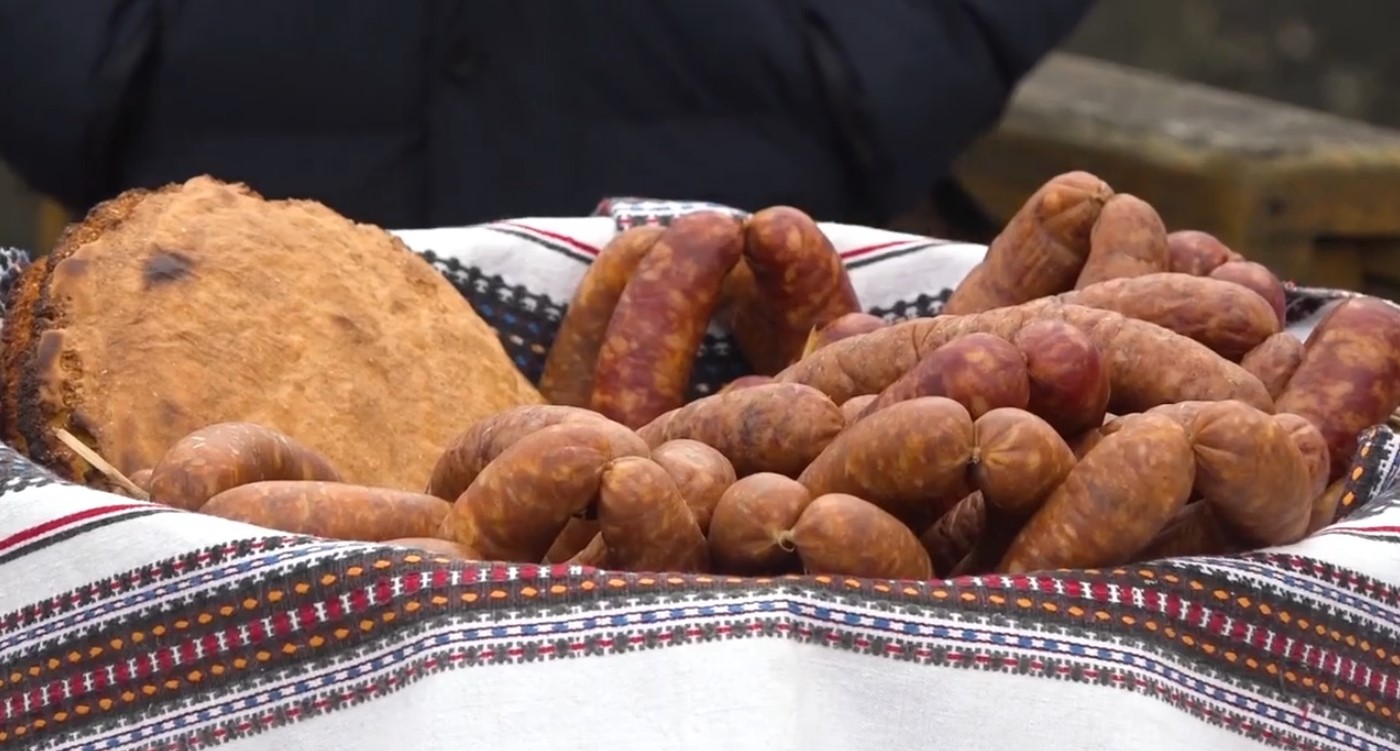
The members of the Ethno Fletno Association are working on protecting Samobor cornbread, usually eaten with Samoborska cesnjofka, but also other home-made dishes. / Screenshot Televizija Zapad
A few years ago, the City of Samobor even launched the Češnofka Festival, but due to the coronavirus pandemic, it was not held last year. This year, it will be held if the epidemiological situation allows it. And not only that. On the occasion of protecting samoborska češnofka, the Deputy Mayor of Samobor, Željko Stanec, announced a center for various Samobor tradition guardians.
Samobor gastronomic delicacies available in the "to go" offer
The diligent hands of the people of this region write the history of taste worth experiencing. Although the restaurants are still closed, all the flavors of the Samobor region are available in the "to go" offer in the "K Gabreku 1929 "cellar, the favorite Kavana Livadić, and "U prolazu" confectionery for the well-known kremšnite in Samobor.
Therefore, you can spend this 'almost' spring weekend in Samobor, 30 minutes away from Zagreb's capital, with protected indigenous flavors. This charming town along the Slovenian border dates back to 1242 and the charter by which King Bela IV confirmed the status of a free royal trading post.
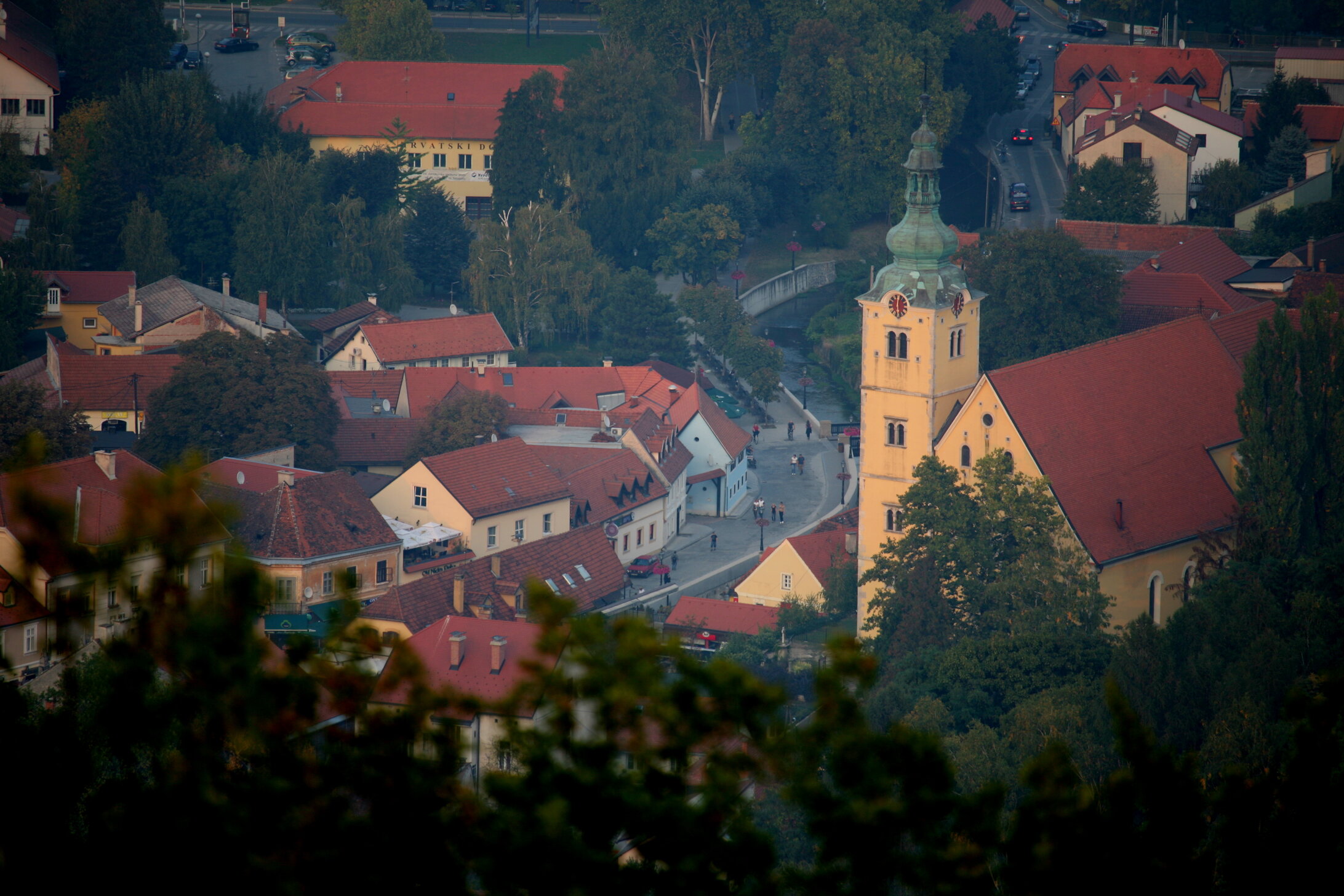
Samobor / Zagreb County Tourist Board
Also, Samobor Square is one of the few where all buildings are protected monuments of the first category. Right next to the main square, in the Filipec family tasting room, you can taste another Samobor gastronomic icon – bremet, the most famous liqueur in the Zagreb region. Samobor bermet is an aromatized red wine made from selected varieties of Portuguese and Frankovka grapes with wormwood and southern fruit. The secret recipe dates back to the time before Napoleon.
Zagreb people's favorite excursion destination
This urban pearl of Zagreb County, with its preserved old town, but also with numerous cultural sights, has always attracted excursionists and tourists.
A walk through Samobor comes across the Samobor Museum, the former dock of the composer Ferdo Livadić and a gathering place for cultural greats of that time. The Old Samobor Town ruins, a former castle that watches over the town in the lowlands, hide its turbulent history.
From 1268 until recently, this building was owned by many different families. It used to flourish with life, and now there is only one beautiful monument left to the destructive ravages of time. Over the centuries, numerous nobles and kings were the lords of Samobor-grad, from the Czech king Otokar, who built it in 1268, to Arpadović, Frankopan, Erdody, Matija Korvin, and many other blue blood families.
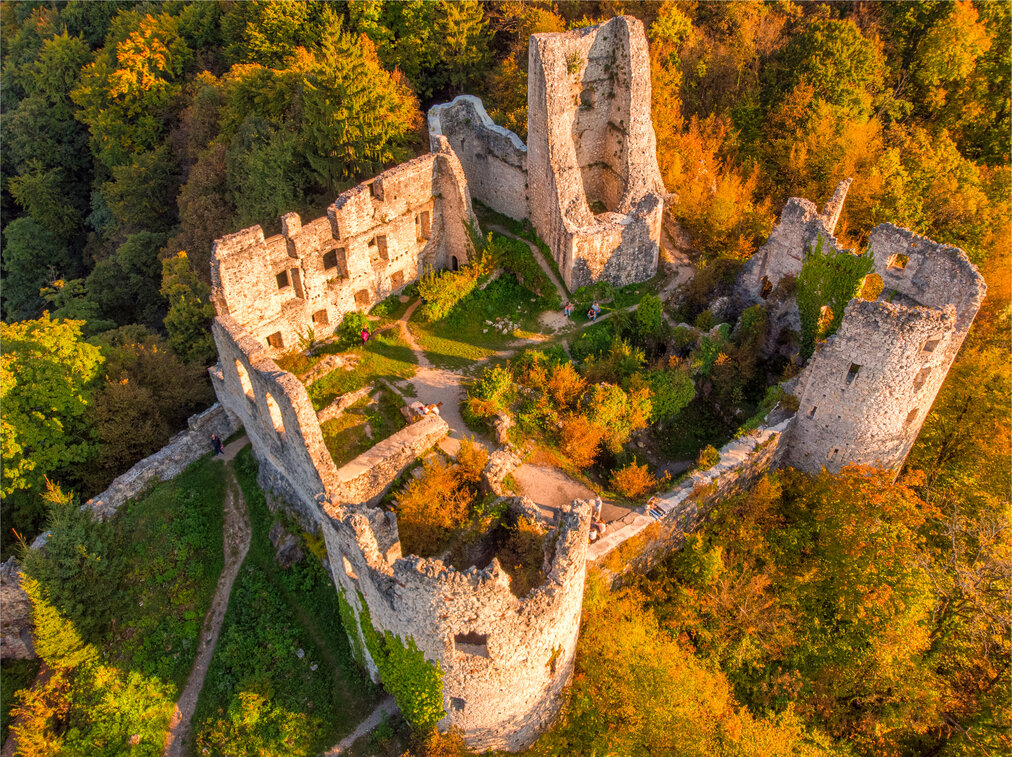
Ruins of Samobor Old Town / R. Klarić, Zagreb County Tourist Board
As the owners changed, so did this castle. In 1902, the Old Town ended up in Samobor's ownership for 5,293 crowns. Since then, attempts have been made to rebuild it, but no attempt has borne fruit. But maybe even better, because the castle in this form has some magic that it might not have if it wasn't in this state. There is a spirit of the time in it. It hides among the walls and swims among the surrounding trees. This place truly breathes some unique energy. The fort is located in a forest not far from the center of Samobor.
Oh, and did you know that Samobor's Old Town was almost fatal for Jackie Chan, who nearly perished here while shooting the famous film God's Armor?
Oldest mine, nature park, mountain peaks, and educational trails
Only five kilometers away from Samobor, in the Rude village, you can visit the Mine of St. Barbara, one of Europe's oldest copper and iron mines. This small settlement gave rise to the mentioned first protected gastronomic product of the Zagreb County – a crispy salt pie Rudarska greblica, once a modest snack of local miners.

Rudarska greblica / Josip Škof, Zagreb County Tourist Board
Outside Samobor, with a walk in the fresh air, unforgettable views uphill of the Samobor Hills, a protected Nature Park together with Žumberak, await to be discovered. There are many marked trails, and they will satisfy both beginner walkers and ambitious climbers. Although none of them is higher than 1000 meters, the peaks Oštrc, Japetić, and Okić are key places in Croatian mountaineering.
The first trip under the Croatian Mountaineering Association's auspices was organized in 1875 to Oštrc, and the ascent of the writer Dragojla Jarnević on the steep side of Okić in 1843 was Croatian's first recorded alpine venture.
You can add an educational note to the trip by visiting the Budinjak Eco Center and the Educational Trail of Princes, a prehistoric site with a site of old burial mounds, or the Ethno House under Okić. In this rural household, time stood still more than a century ago.
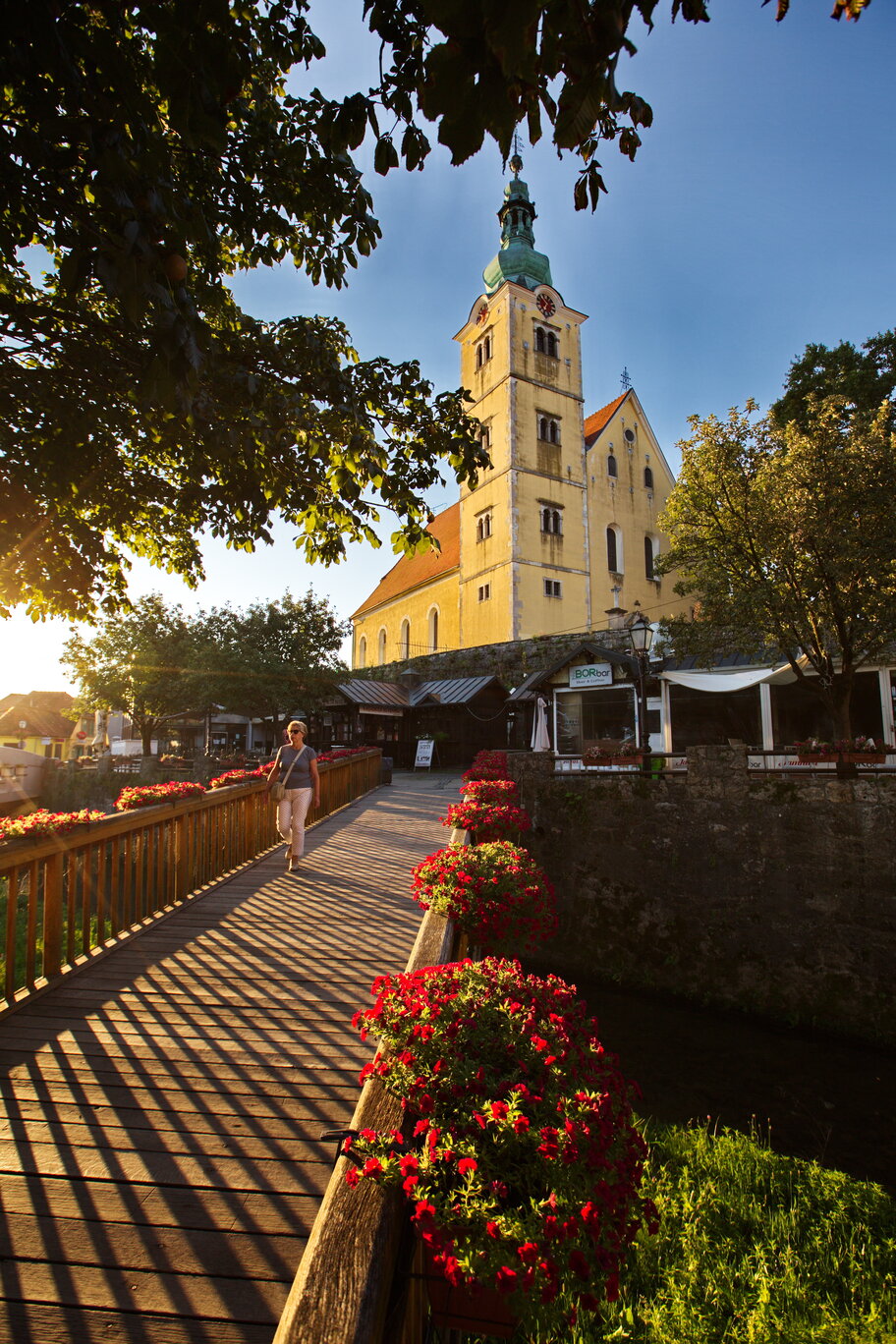
Welcome to Samobor / Josip Škof, Zagreb County Tourist Board
Source: Zagreb County Tourist Board
To read more news from Croatia, follow TCN's dedicated page.
PHOTOS: Outstanding Contemporary Croatian Architecture of the Year
February 10, 2021 – 10 of the most outstanding examples of contemporary Croatian architecture have been selected by the Association of Croatian Architects to compete in the extremely prestigious Mies van der Rohe Awards. Held only once every two years, they are the European equivalent of the Pritzker Prize for Architecture.
The Mies van der Rohe Awards are a really big deal. The greatest works of European architecture compete for recognition in the competition. The greatest success of Croatian architecture in the awards was attained by UP studios' Toma Plejić and Lea Pelivan, who received a special award for upcoming architects and had their high school in Koprivnica named the best building in that category in 2009. The success has had a considerable impact on their careers since.
Being held only once every two years, Croatian architecture projects completed since the closure of entries for the 2019 awards are eligible to be submitted. Here are the outstanding examples of contemporary Croatian architecture that will represent the country in 2022.
Cinema Urania Zagreb
An old neighbourhood cinema built into the back streets near Kvatric. In their redesign, 3LHD preserved the best features from this early example of concrete engineering in Croatian architecture. They added a glass pavilion at the entrance, atriums and skylights, flooding the former darkness with the natural light needed for its new purpose as an event and work space. © Jure Živković
© Jure Živković
Grand Park Hotel, Rovinj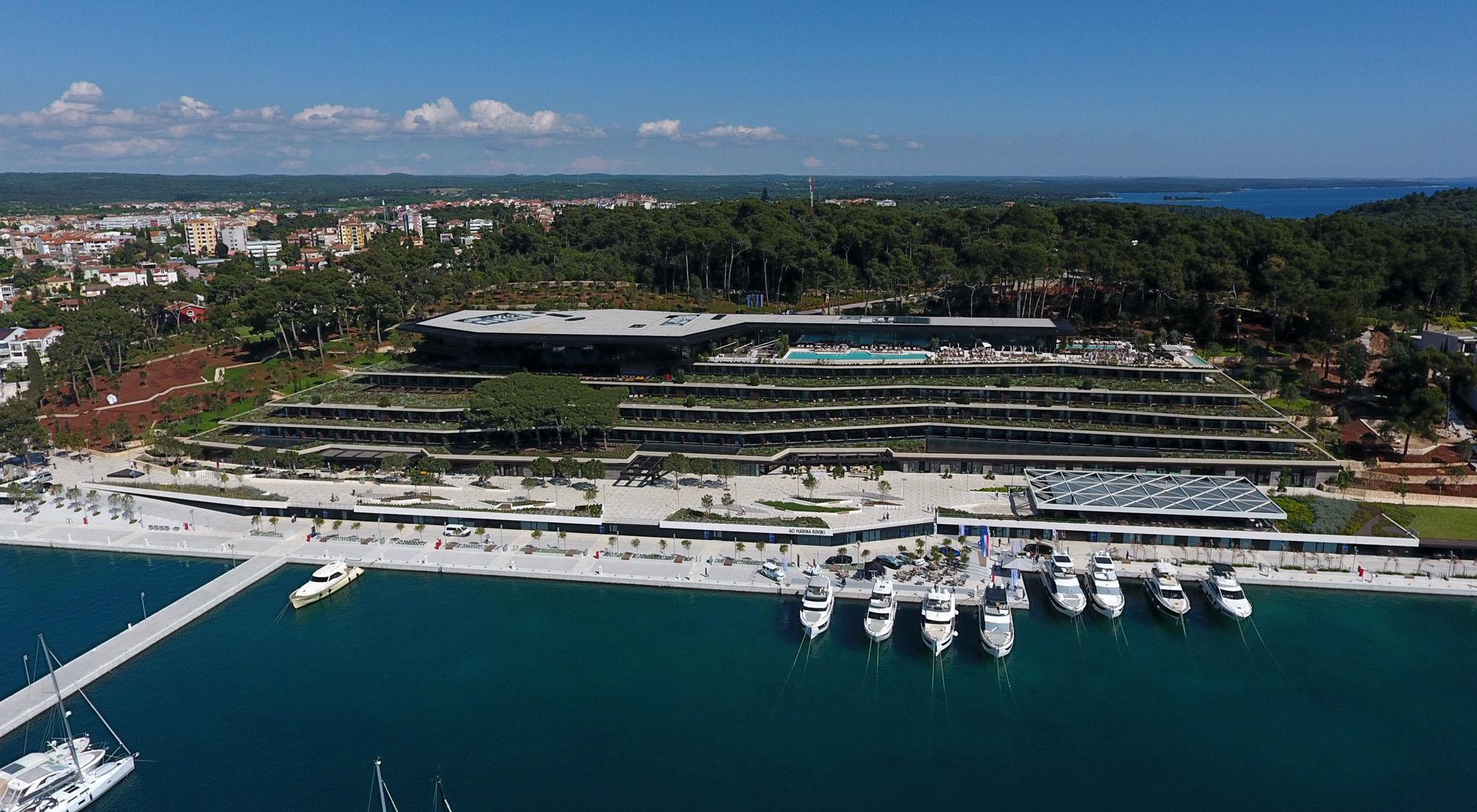
Sprawling widely across six stepped levels, the new luxury Grand Park Hotel and spa could easily have looked a long swipe of concrete. But, by places greenery on each of its staged roofs, architects 3LHD have ensured that no matter where you are in the 500-guest-capacity building, your view places you within a garden, looking out onto Rovinj Old Town and the expanse of the Adriatic. Croatian architecture at its most breathtaking. © Alukoenigstahl hr
© Alukoenigstahl hr
Ivanja Reka Elementary School, south Sesvete, east Zagreb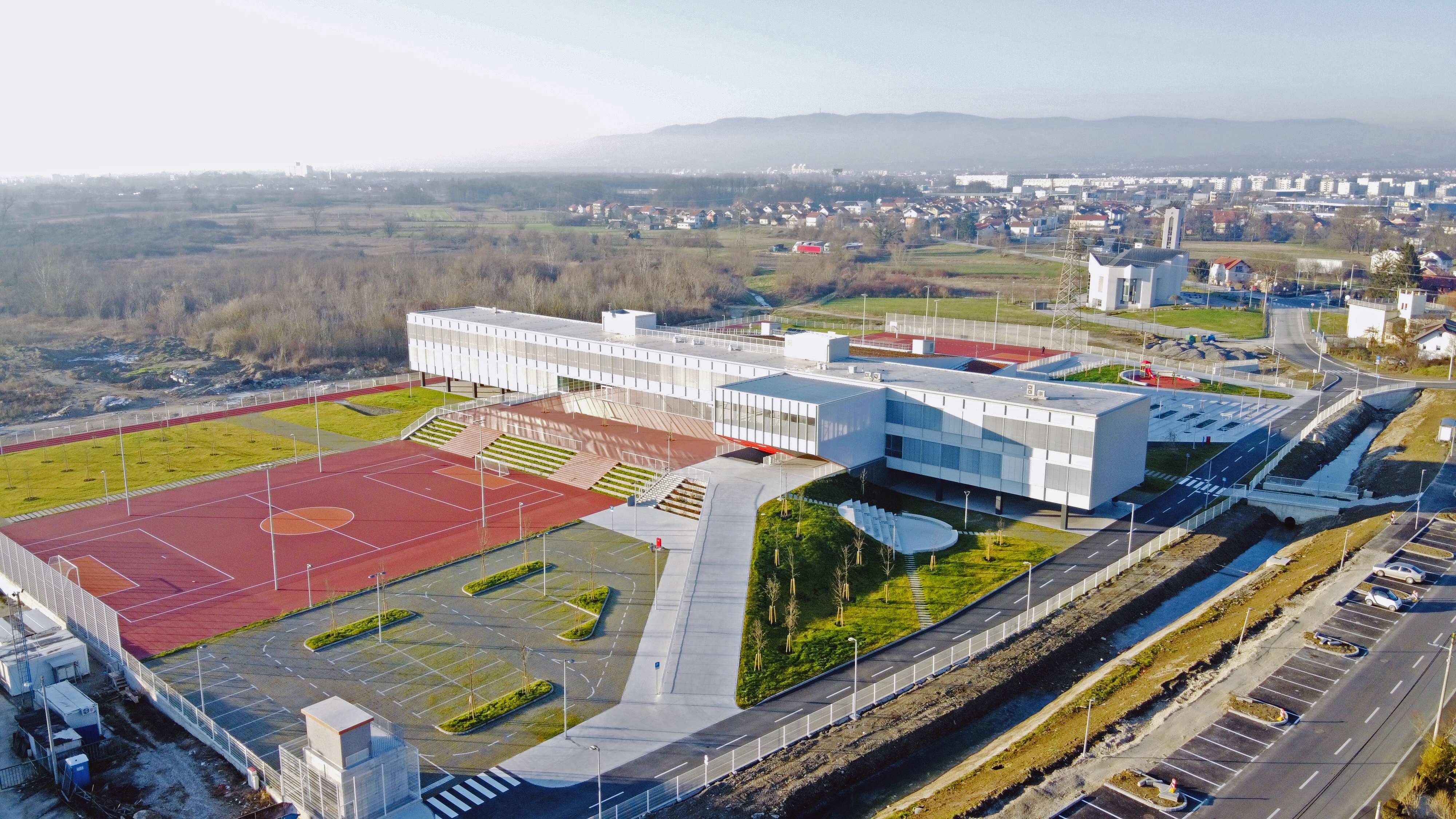
If every elementary school looked as pretty and was as well equipped as Ivanja Reka Elementary School in the south of Sesvete, eastern Zagreb, you could well believe daily attendance would never drop below 100%. Designed by a team of architectural authors (SUBMAP studios Marija Burmas and Ivo-Lola Petrić, and Jakša Kalajžić from JKA Arhitekti), the multi-level main building sits centrally, surrounded by sports, recreation and other facilities creating an impressive view for both those outside and within.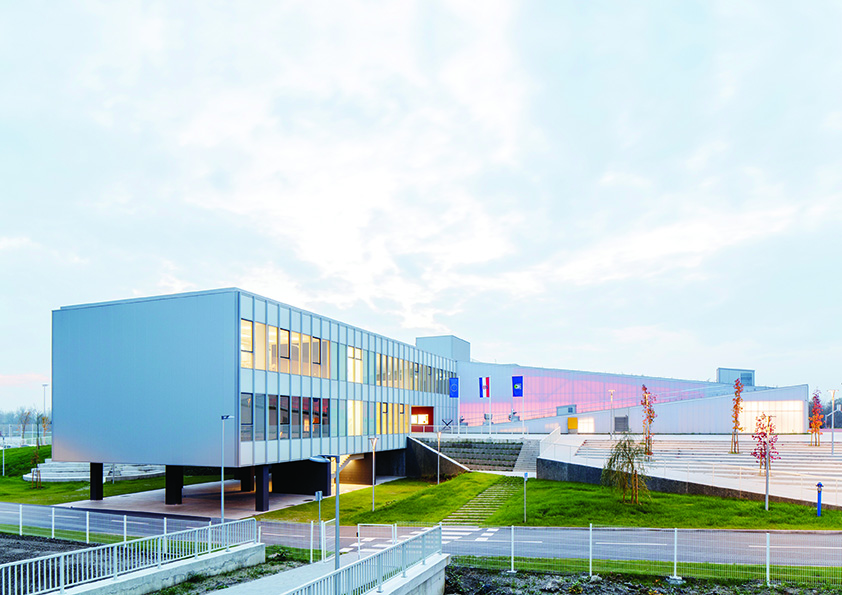 © Ivanja Reka Elementary School / Domagoj Blažević
© Ivanja Reka Elementary School / Domagoj Blažević
Roxanich Wine & Heritage Hotel, Motovun, Istria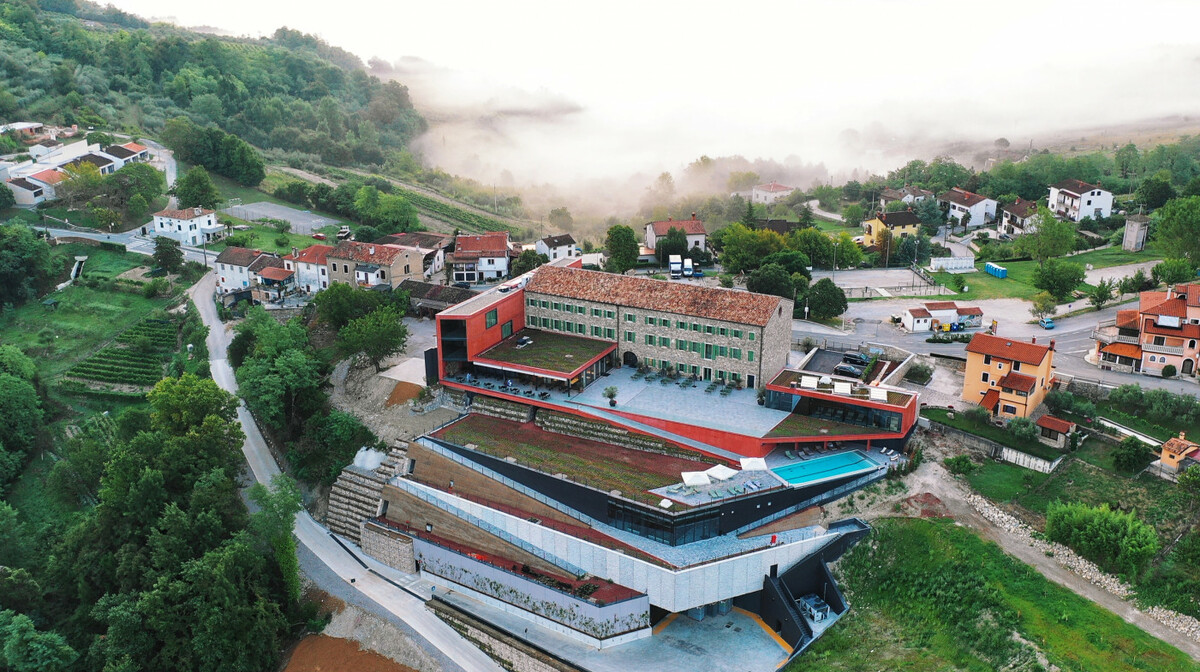
The view is unmistakably Istria. Vineyards carpet the land below and - rising above - the picturesque hilltop town of Motovun. Helmed architecturally by consistently bold Rijeka designer Idis Turato, this multi-level, multi-purpose redesign retains the traditional feel of its existing stone building and its purpose – there's a huge wine cellar beneath – but has opened up the space to give stunning views, not least over a sun deck that spectacularly reflects the sunrise and sunset. This is an active winery, with works and equipment all housed within its lower floors, not that you could tell from the 25 person capacity boutique hotel, restaurant and wine shop upstairs. © Roxanich.hr
© Roxanich.hr
Four Houses for Four Brothers, Diklo, Zadar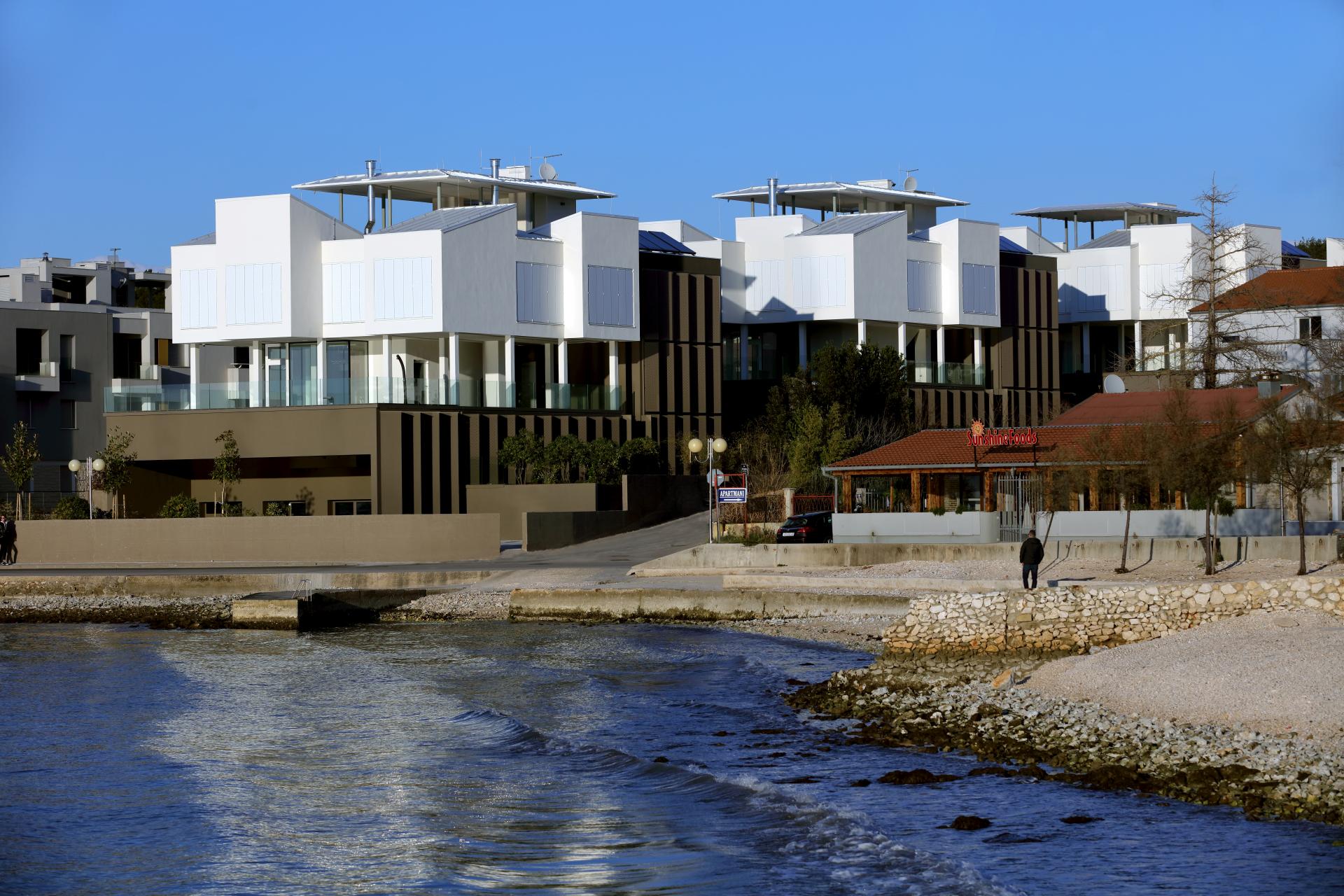
Judging from a theme of project titles used by architects Iva Letilović and Igor Pedišić, we're not sure that Four Houses for Four Brothers was actually commissioned by four brothers or that four live there. But, you could well believe they could. The ultra-modern set of independent houses, located next to a beautiful stretch of coast in a north Zadar neighbourhood, was specifically designed to address a distinctly Croatian reality – how to open up some of your dwelling to seasonal guests while you remain at home. The design separates the buildings clearly into separate quarters which allow privacy, comfort and minimal encroachment for both visitors and residents. © Igor Pedišić
© Igor Pedišić
Galić Winery, Kutjevo
Award-winning outfit Zagreb-based studio Dva arhitekta have an existing, jaw-dropping design for a rural winery commissioned by famous makers Galic. However, that project, as yet, remains unrealised. But, their winery for Galic in the centre of Kutjevo town is complete. Melding the traditional and the contemporary, the upper section of the building is a bold and unblemished red brick, adorned with the winemaker's unmistakable logo. Beneath, concrete arches invite your eyes into the actual wine cellar – neat rows of barrels, protected behind glass walls that are set back from the facade. Brilliant! © Damir Fabijanić
© Damir Fabijanić
Seecel Centre, Zagreb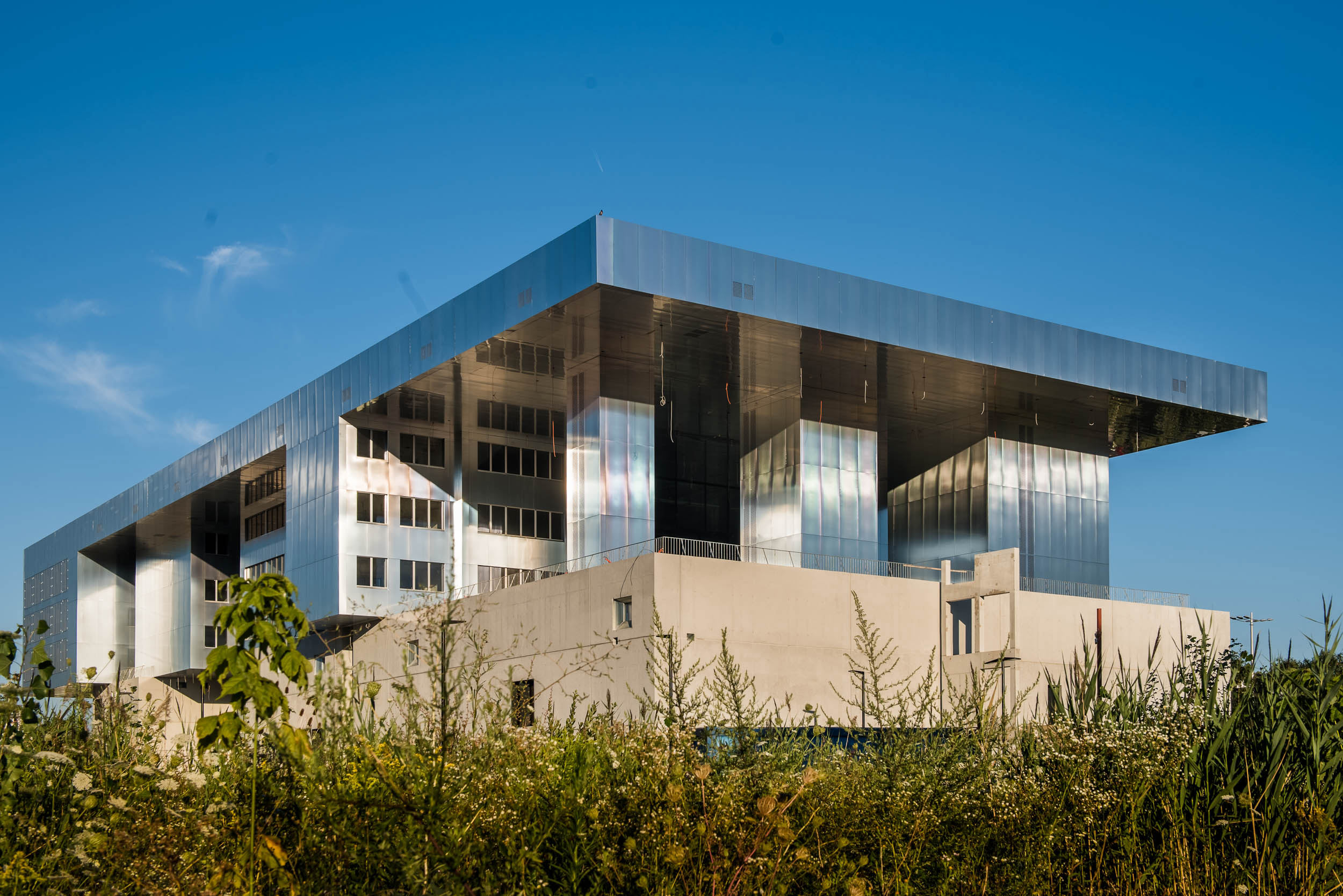
Designed as a regional centre for the development of entrepreneurs and its construction costs generously part-funded by European money, the Seecel Centre arrived long overdue and does not house its intended inhabitants. Such matters are best left for different articles as, here, we're concerned with the undeniable finery of this building's architecture and appearance. Holding space for accommodation, offices, communal collaboration, education and presentations, the five-floored building uses ultra-modern building materials and construction methods to make it low-energy, its great blocks of covered concrete, with glass windows set further back, echoing old fortifications. It was designed by Igor Franić who, in Croatia, is perhaps best known for the Museum of Contemporary Art in Zagreb and completed by him and his team at SZA / Studio za arhitekturu d.o.o.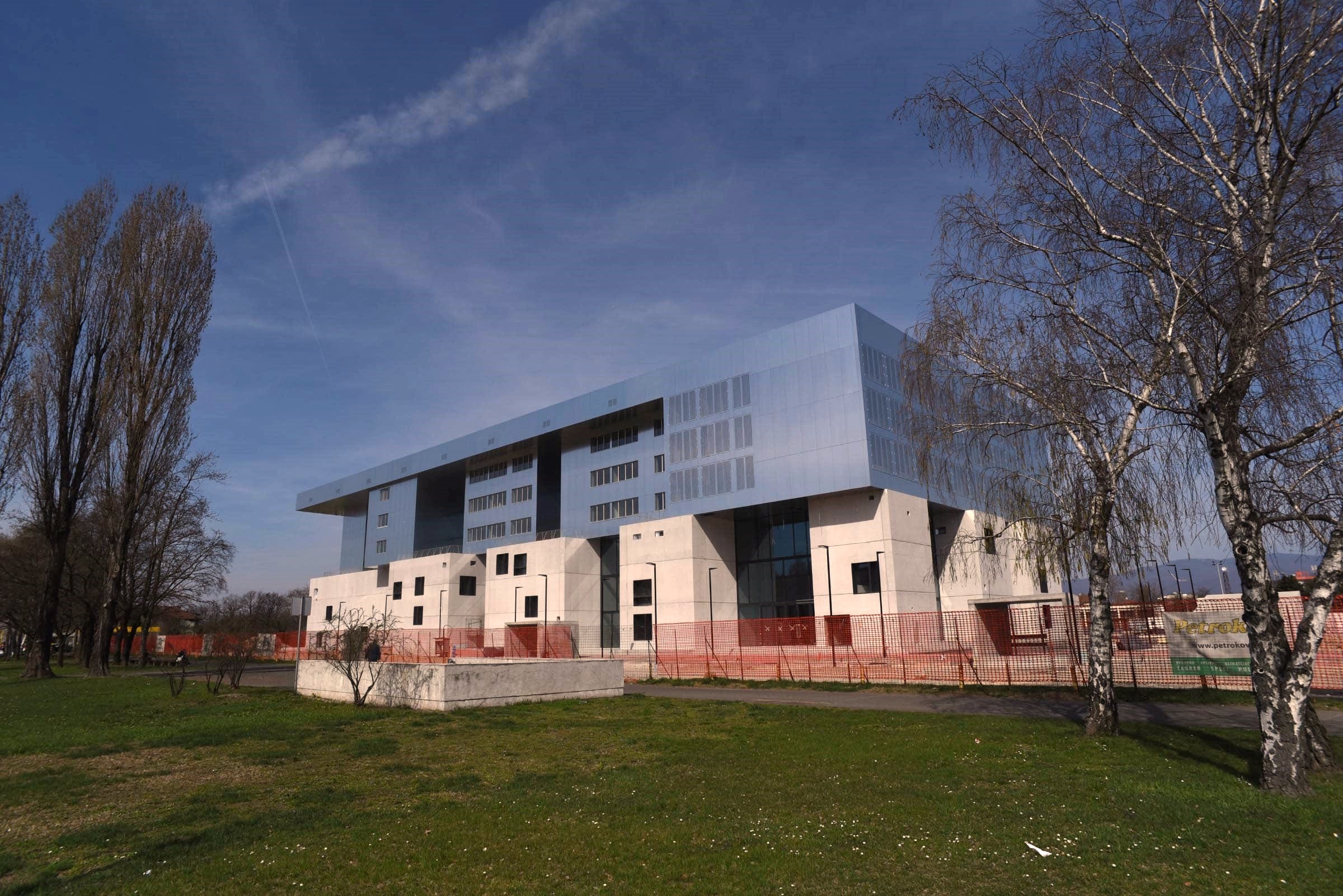 © Site Project d.o.o.
© Site Project d.o.o.
Trg Poljana, Šibenik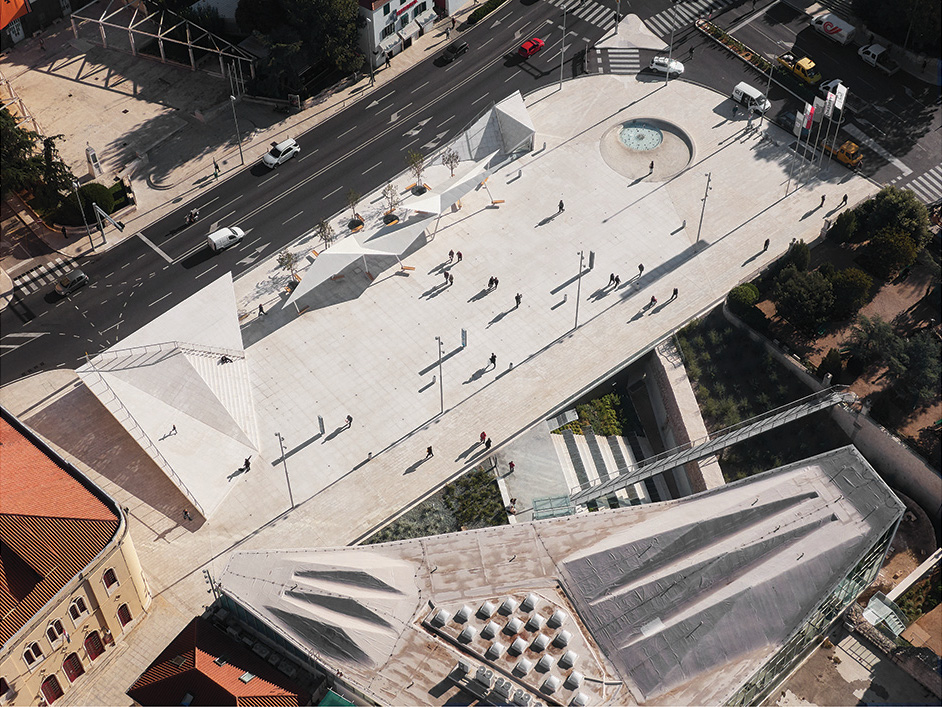
Not a small amount was asked of project architects Atelier Minerva from Dubrovnik in the task to create Trg Poljana in Šibenik. The site had long been earmarked for a much-needed, official town square – a place for events and public gatherings. But, the town was also woefully short on parking. By burying a multi-level car park beneath the open space, the architects successfully met both demands. Triangular shapes sit at an angle above shaded seating, echoing the inclines on the roof of the Juraj Šižgorić City Library opposite. Clever.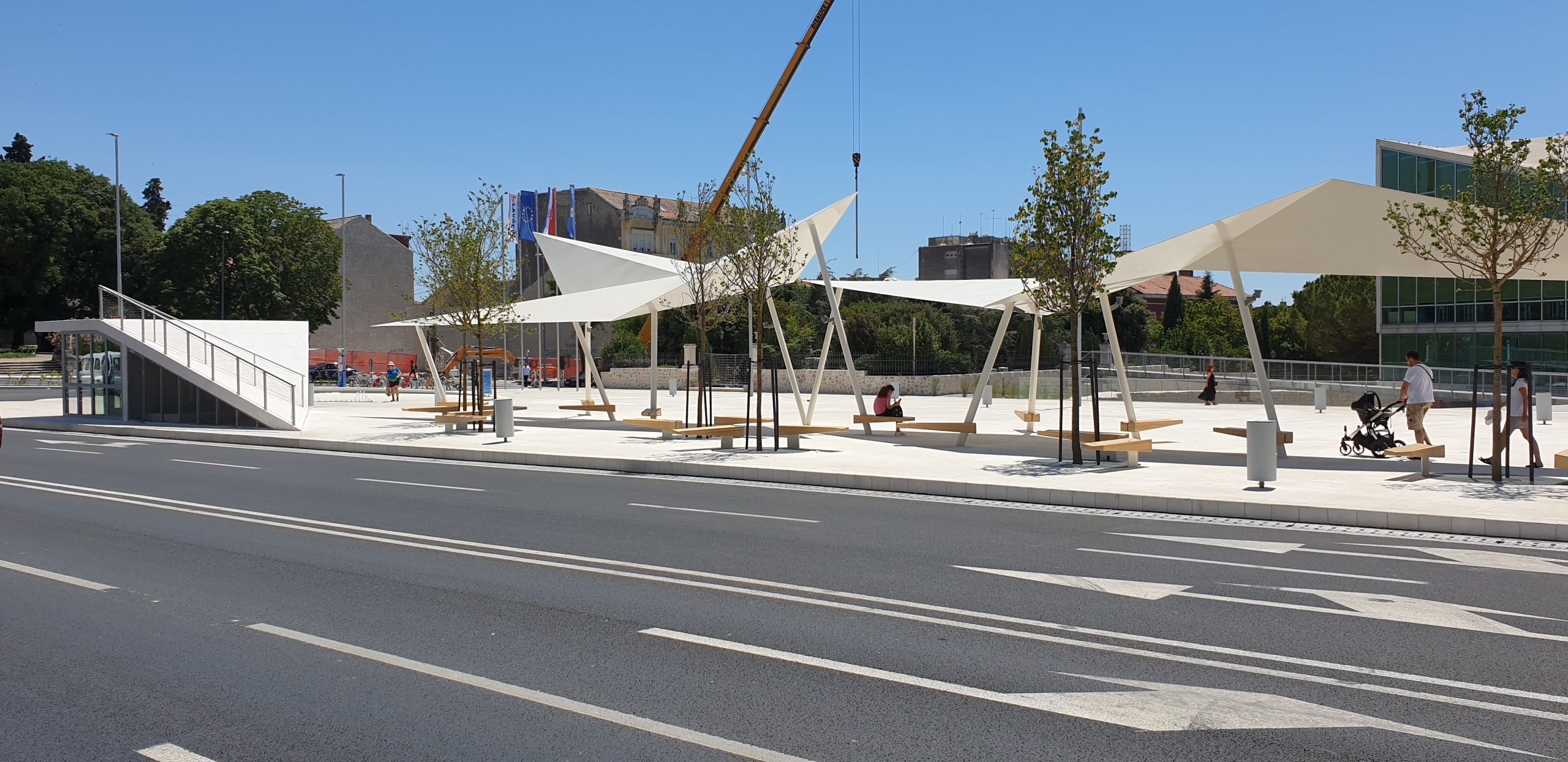 © Ervin Husedžinović / Eccos-inzenjering
© Ervin Husedžinović / Eccos-inzenjering
Homestead on Hartovski vrh, Žumberak, Zagreb County
A collection of multi-purpose rural buildings, Homestead and Meditation Centre on Hartovski vrh was commissioned and designed for use by the Buddhist Center Zagreb. Their aim was to relocate activities such as chan, yoga, meditation, healthy living and teaching to a peaceful retreat outside of the city. Architects Branimir Rajčić and Mariela Žinić began the project in 2015, with the completed site arriving in 2019. Modern building materials are used, but not so the striking collection seems out of place within a partially agricultural setting. The set of buildings includes a residential dwelling and a larger hall for meetings and activities, both of which use large windows to allow the light and nature to flood in. © Robert Leš
© Robert Leš
Square of Traditional Crafts, Varaždin
A tricky task was given to architects Studio Konntra – how to enliven and modernise a traditional old square in the centre of one of Europe's best-preserved Baroque Old Towns. They did this by constructing transportable kiosks to house small outlets for local artists and craftsmen that cater to visiting tourists who come to the square. When occupied during the day, the plain wooden interiors allows the crafts to take centre stage. But, after closing time, the outsides of the wooden doors are brightly coloured and adorned with paintings, a welcoming environment for residents to use at night.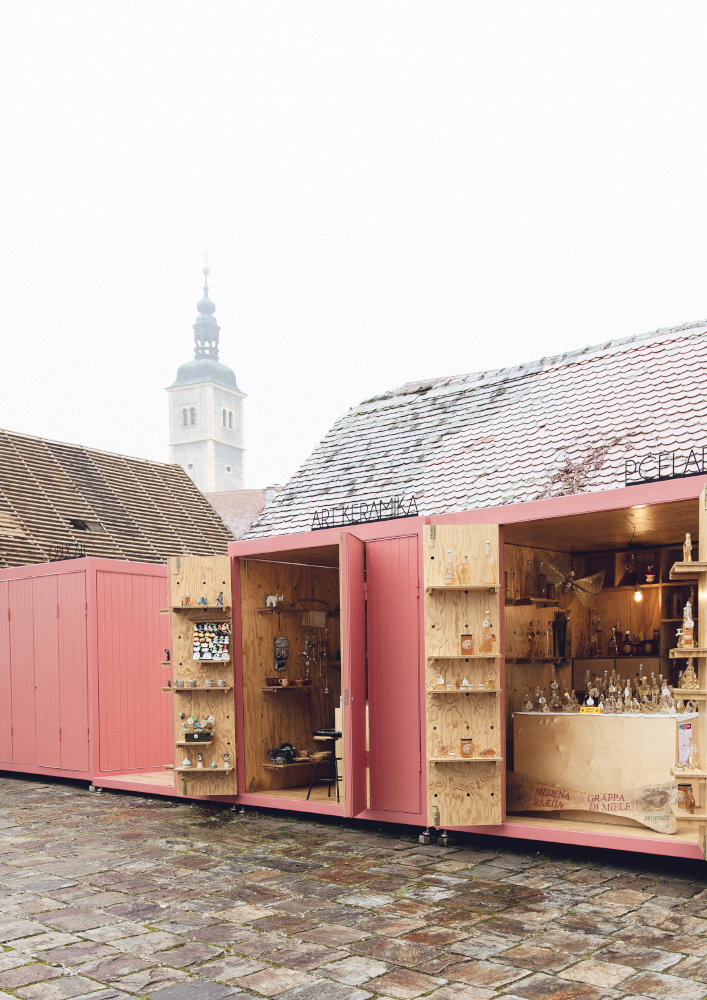 © Studio Konntra
© Studio Konntra
Zagreb County as It Once Was: Celebrating Patron Saints in 1930 (VIDEO)
February 8, 2021 - Traditions are very important in Croatia; some delightful footage of village life in Zagreb County in 1930 celebrating the feast day of the local patron saint.
When it comes to upholding traditions, I have never come across anywhere as diverse as Croatia.
It took me a while to realise, but seemingly every village has its own traditions, its own patron saint, and even many have their own traditional costume.
The celebration of the patron saint of the village is an eagerly-anticipated affair, and I always found it heartwarming to see these celebrations taking place in each and every village on the island of Hvar when I lived there - many of them in winter.
Upon deeper investigation, I was surprised too by the sheer variety of traditional costumes all over the country, each helping to define and give personality to the community.
As Croatia looks to reorient its tourism after the pandemic, these authentic experiences are jewels to build on, an area of Croatian tourism which should be developed and promoted a lot more in my opinion.
And a lot of these traditions have changed little over the centuries, including the music and song that accompanies them. Check out this delightful footage of Zagreb County almost a century ago, where the villagers are celebrating the local patron saint on May 17.
The authentic nature of village life in places like Zagreb county still exists today, and these local celebrations are wonderful windows into the traditional way of life here.
It is authentic village life which is very accessible on a day trip from Zagreb, made even more so by the new platform, Around Zagreb, which was launched last year by the city and county tourist boards. And if you are looking to catch one of these villages on its special day, the tourist board should be able to help with some options.
For more on travel in Croatia, follow the TCN Travel section.
Tourist Boards in Zagreb County Develop Gourmet and Cultural Tourism
January 19, 2021 – Tourist boards in Zagreb County are uniting in two projects – to develop and promote cultural and gourmet tourism.
The new Law on Tourist Boards and the Promotion of Croatian Tourism encourage the tourist boards' association, both project-wise and formally. Local and regional tourist boards, as well as tourist boards and local self-government units that do not have an established tourist board for their area, may join a project (agreement) association.
Many tourist boards have already taken advantage of this opportunity, such as the Zadar Archipelago and Southern Istria tourist boards, and more recently, the tourist boards in Zagreb County.
Namely, they unite to promote and develop cultural and gourmet tourism. As the Zagreb County Tourist Board director Ivana Alilović points out, their goal is to intensively promote the Zagreb Green Ring region and existing tourist products and programs.

Scene from Zagreb County / Romeo Ibrišević, Zagreb County Tourist Board
"Our goal is integrated quality management of the Zagreb County's tourist destination product, which will reduce the gap between the level of quality that tourists expect and the level of quality that the destination can provide and deliver. Also, we want to improve the quality and content of Zagreb County tourism product, increase tourist satisfaction and tourist spending in Zagreb County and the benefits for entrepreneurship in catering and tourism," says Alilović.
Gourmet tourism in Zagreb County
Local tourist boards of Jastrebarsko, Samobor, and Sveti Ivan Zelina cities have concluded an agreement on the local Zagreb County Tourist Boards' association. In this first project, the joint activity will be the development of gourmet tourism. Wine roads and cheese roads are among the many tourist attractions of rural, eno, and gastro tourism of Zagreb County.
Vineyards and wine cellars in Zagreb County are located on three wine roads – Plešivica Wine Road, Zelina Wine Road, and Samobor Wine Road. Along wine roads, you can find Purtugizec Plešivica and Kraljevina Zelina wines from the Zagreb County brand, as well as Bermet, a traditional and widely recognized Samobor aromatized wine.
Also, there are wines produced from indigenous varieties Plavec yellow, sweet Zelenac, and Šipelj, and many other wines such as Chardonnay, Sauvignon, black, gray, and white Pinot, Rhine Riesling, Traminer, Frankovka, Škrlet, yellow Muscat, Šipon.
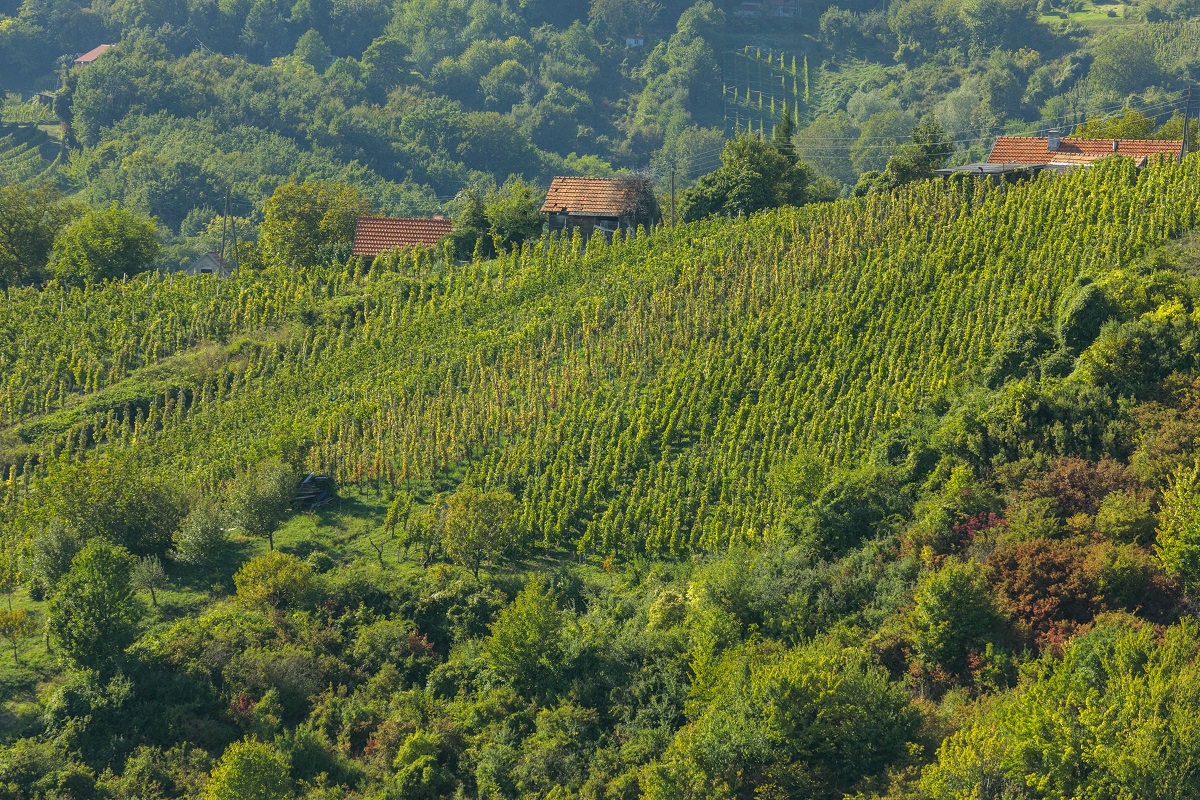
Vineyards in Jastrebarsko / Copyright Romulić and Stojčić
The main goals of the association through the gourmet tourism project are:
- The smart specialization of Zagreb County.
- The development of a tourist destination for gourmet tourism.
- Improving the value chain of gourmet tourism.
- Digitalization and application of new technologies.
- Multi-sector connectivity.
- Development of local production systems (Agri-food).
- Positioning and promotion of Zagreb county.
Cultural tourism in Zagreb County
Cultural tourism in Zagreb County is based on protected natural heritage and cultural and historical heritage. Zagreb County has a rich treasury of natural heritage and beauty. It has many protected natural areas, which contribute to the development and success of cultural, hiking, picnic, and sustainable tourism in Zagreb County.
The association project aims to establish a basis for the integrated management of cultural tourism. Alilović says they want to create a recognizable tourist destination product that will be the main instrument for encouraging tourism competitiveness in Zagreb County. She adds that cultural resources are the leading destination's product in the promotion of a tourist destination, and what makes one destination different from the other is its intangible cultural heritage.
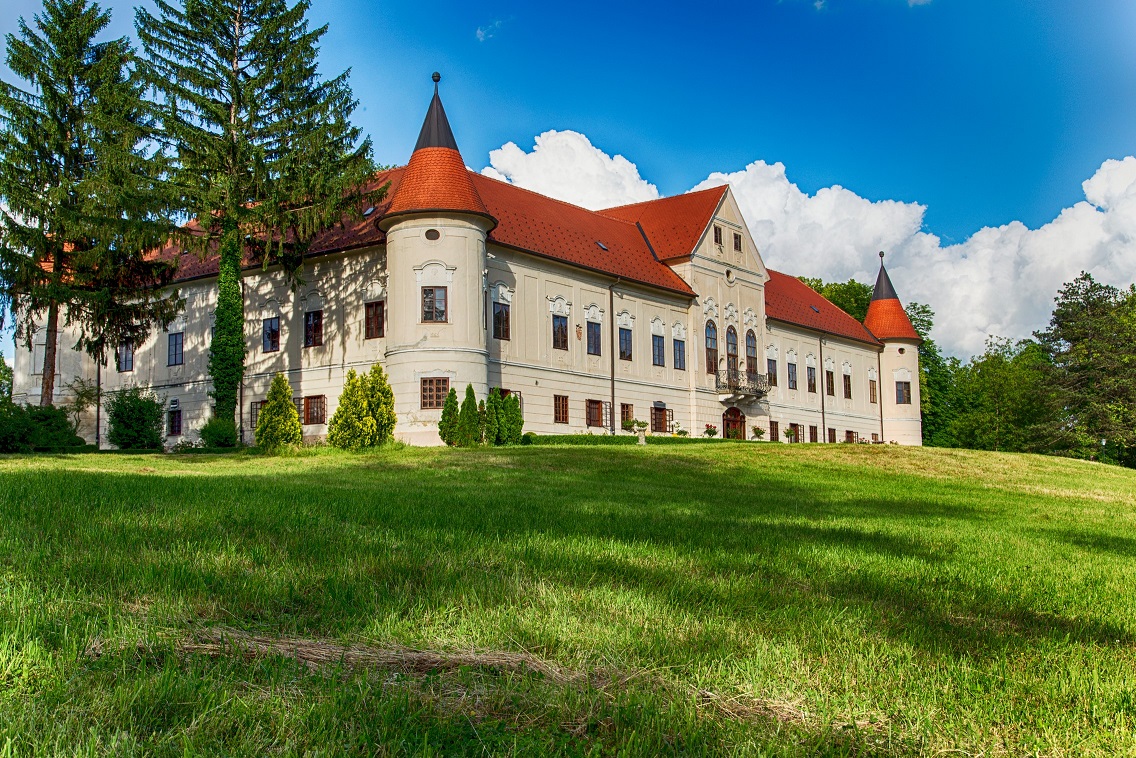
Lužnica Castle, Zaprešić / Zagreb County Tourist Board
"Heritage is the essential element by which a tourist destination's management attracts tourists to the destination. It is an attractive basis for branding. Creativity based on traditional intangible heritage thus pushes the boundaries of the mere functionality of a product.
Through the example of a cultural thematic route, we seek to show how myth can become a potential attractive basis for the development of mythological tourism in Zagreb County. The thematic route's stories and locations offer a choice according to criteria of collective and personal importance. Therefore, the thematic route is an open system that can be toured individually or organized with expert tourist guidance.
Special attention was given to the local identity. For example, the customs of St. George and St. John were highlighted, as well as other customs that are traditionally woven into the Zagreb County and surrounding regions," says Alilović.
The tourist offer of Zagreb County abounds in cultural and historical heritage, such as stories and legends, wooden construction, sacral construction, indigenous architecture, and archaeological finds and monuments of its rich past.
Zagreb County can also boast more than 200 cultural and historical heritage sites. Among them, castles Novi dvori Jelačićevi are a unique example of a complete manorial-economic complex preserved to this day. Then there are forts, manor houses, rich wooden sacral heritage, of which the most prominent is the chapel of St. Barbara in Velika Mlaka. A beautiful example of autochthonous secular architecture is the manor house (curia) Modić-Bedeković in Donja Lomnica. A special attraction is the memorial room of Alojzije Stepinac in Krašić.
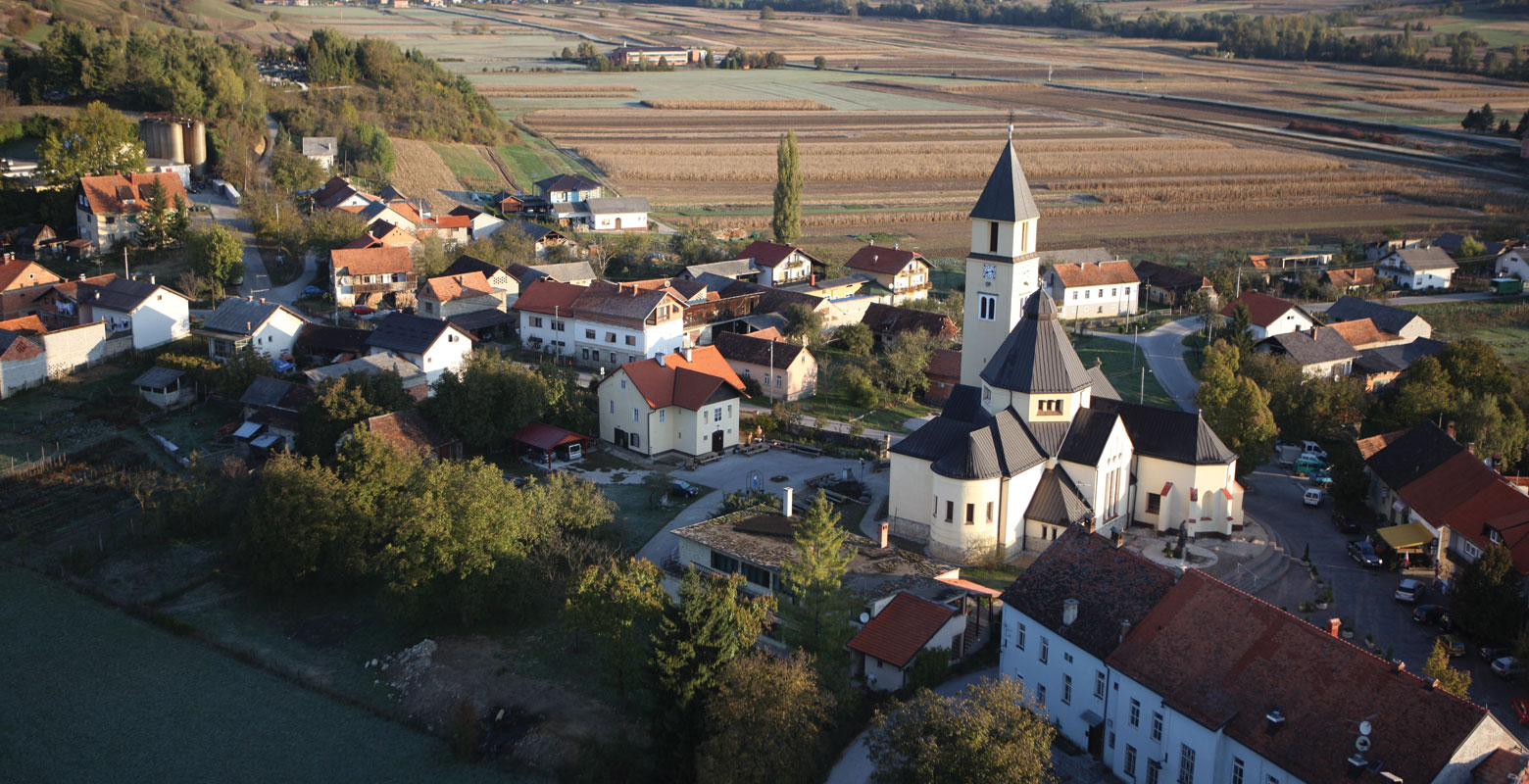
Krašić, Zagreb County / Zagreb County Tourist Board
Valuable is the archeological finds in Ščitarjevo, not far from Velika Gorica, and Budinjak (10th-6th centuries BC), one of the most important prehistoric archaeological sites in Croatia.
The project area includes the tourist boards of the cities of Zaprešić, Velika Gorica, Vrbovec, and Dugo Selo, the tourist boards of the municipalities of Pisarovina and Krašić, and the tourist board of area of the Sava-Sutla valley and hills.
"Agreements of project association in the Zagreb County Tourist Board are an example of planned activities. It is clear that the destination through joint action has the opportunity to better position itself in the market and develop projects that will stimulate overall economic development," said Alilović.
Alilović concludes that the association should result in numerous synergy effects. Not only in quality but also much-needed cost-effectiveness of promotion and project implementation.
For the latest travel info, bookmark our main travel info article, which is updated daily.
Read the Croatian Travel Update in your language - now available in 24 languages.
Join the Total Croatia Travel INFO Viber community.
PHOTOS Unforgettable View of Snow-Capped Alps from Japetic
January 20, 2021 – A white blanket of snow covered many Croatian destinations, including one of the most popular excursion sites – Japetic, the highest peak of Samobor Hills. At this time of year, Japetic offers a beautiful view of the Alps, and photographer Josip Škof captured these unforgettable snow scenes last weekend.
At 879 meters above sea level, Japetić, the highest peak of Samobor Hills, is a favorite Croatian destination for picnickers and hikers. Due to its preserved natural beauties, Japetić has been declared a reserve of forest vegetation.

On one of the trails, not far from the top, a lookout tower was built in 1889, when the Eiffel Tower was also built. The iron pyramid-lookout is 12 meters high and is under the protection of the Ministry of Culture. Until 1960, it was at the top of Medvednica mountain, but it was moved after the construction of the television tower on Sljeme.
A little above the lookout at the top of a steep meadow is the famous mountain lodge Žitnica, from whose terrace you will also find a beautiful open view of the surrounding Pokuplje hills area in the distance.

Popular Japetić lookout offers a view of the nearby peaks of Sljeme, Oštrc, Okić, Klek, Plešivica, Sv Gera, and even Bjelolasica, Risnjak. In clear weather like these days, especially in winter, even the Alps can be seen.
Last snowy weekend, while some people visited destinations such as Plitvice Lakes and ski resorts in Gorski Kotar and Lika, photographer Josip Škof stayed in Zagreb County, capturing the snow-capped Alps from the winter-bound Japetić.
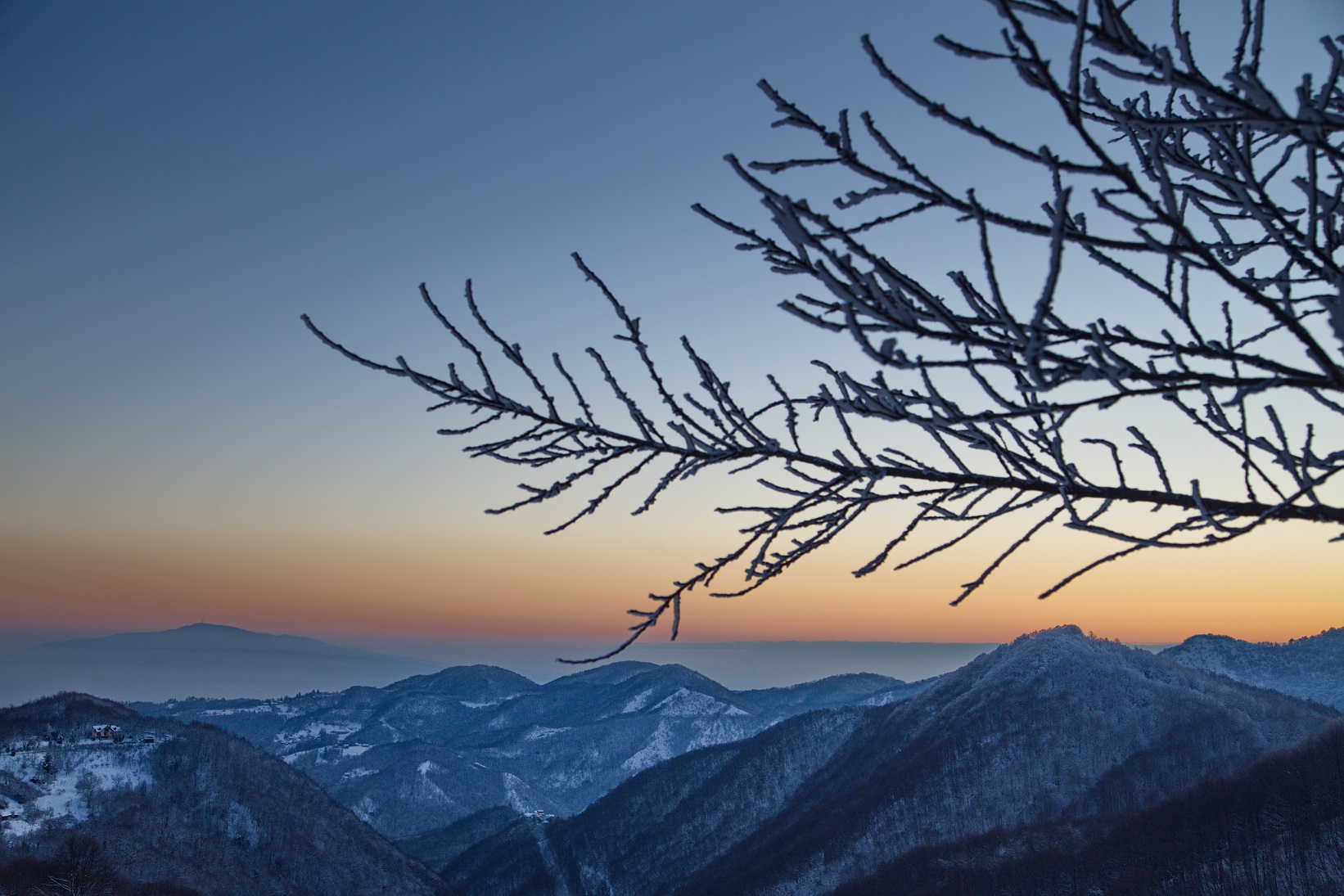
And he was not the only one because Japetić is one of the most exciting lookouts in Zagreb's vicinity, only half an hour drive away. It is an unavoidable destination for visitors during the winter because of the snow that covers the old beech forest, creating a winter idyll, but also because of the unforgettable view of nearby peaks.

"I can't find the words to describe the scenes that were created in front of me. Luckily, I brought my camera, so I can most faithfully show you what views I enjoyed this weekend. I also chose the right day, and my view reached as far as Triglav peak, about 150 kilometers away. A little closer, approximately 120 kilometers, the Kamnik Alps were in the palm of my hand," said Škof in his Facebook post, telling us to enjoy the beautiful photos of his beloved native Zagreb County.
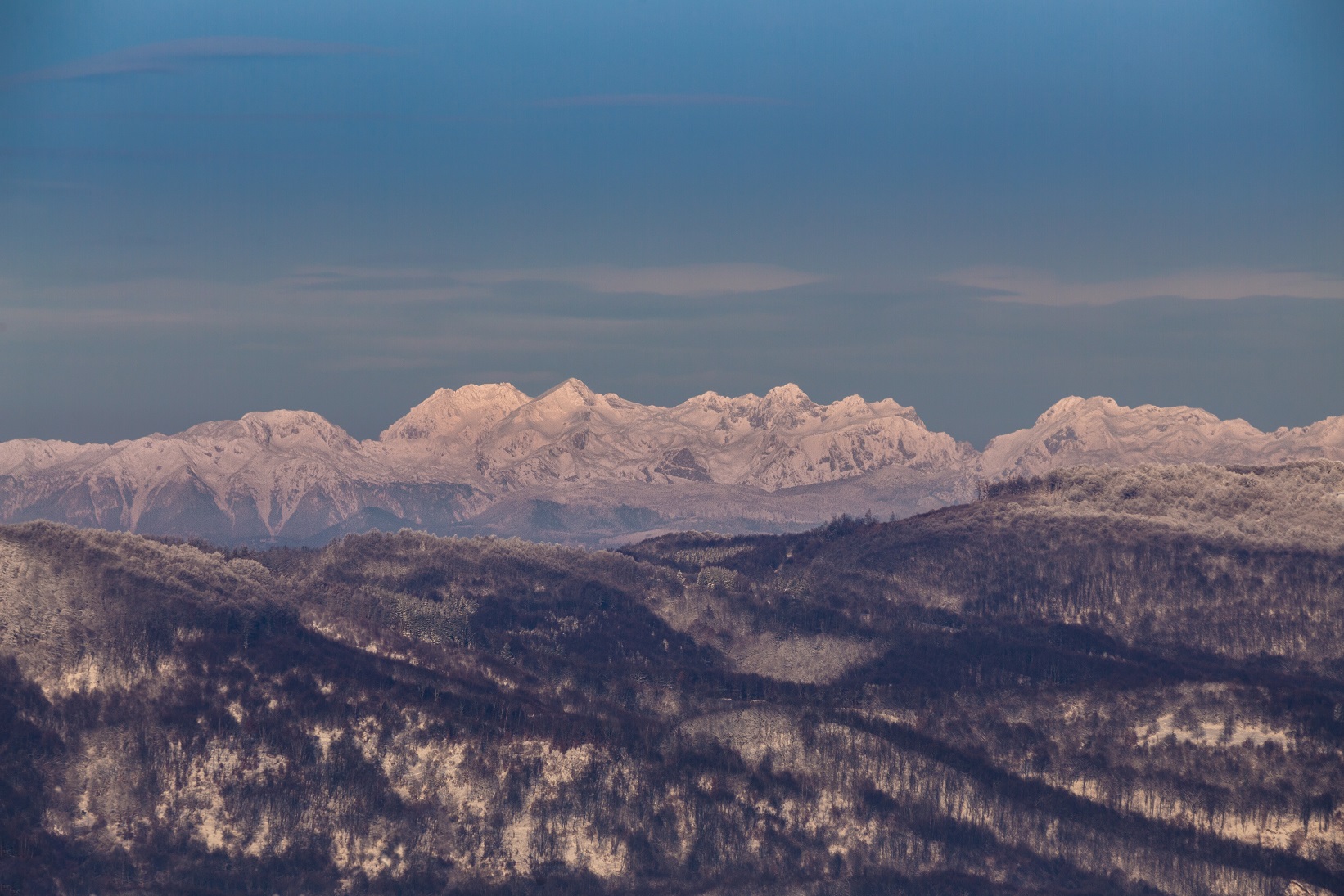
Although Alpine ski resorts are inaccessible to us this year due to the coronavirus pandemic, it is almost unbelievable that we still have the opportunity to see Alpine peaks from the Zagreb neighborhood. Marked hiking trails from Ivančići and a good road over Draga Svetojanska lead to Japetić.

The ascent to Japetić is not overly demanding, and the scenes of winter idyll are worth experiencing. Josip Škof's photo gallery is calling us to take the opportunity and go to one of Croatia's most interesting lookouts, only thirty minutes away from the Croatian capital of Zagreb.


All photos: Zagreb County Tourist Board / Josip Škof
For the latest travel info, bookmark our main travel info article, which is updated daily.
Read the Croatian Travel Update in your language - now available in 24 languages.
Smart City Ivanic-Grad Gets Solar-Farm Buildings and Super Fast Internet
January 4, 2020 – Following the introduction of free WiFi in public places, Smart City Ivanic-Grad surges forward with smart technologies, constructing a solar power plant on public buildings and introducing ultra-fast internet for all
Teenagers in Ivanić-Grad have cast their eyes down the tracks ever since the railway came to town. You can understand them doing so. Less than 40 kilometres from the cool, contemporary European capital of Zagreb, day trips to the excitement and buzz of the big city are looked forward to and taken at any opportunity. But, over recent times, Smart City Ivanic-Grad has been edging towards becoming its own little centre of contemporary cool.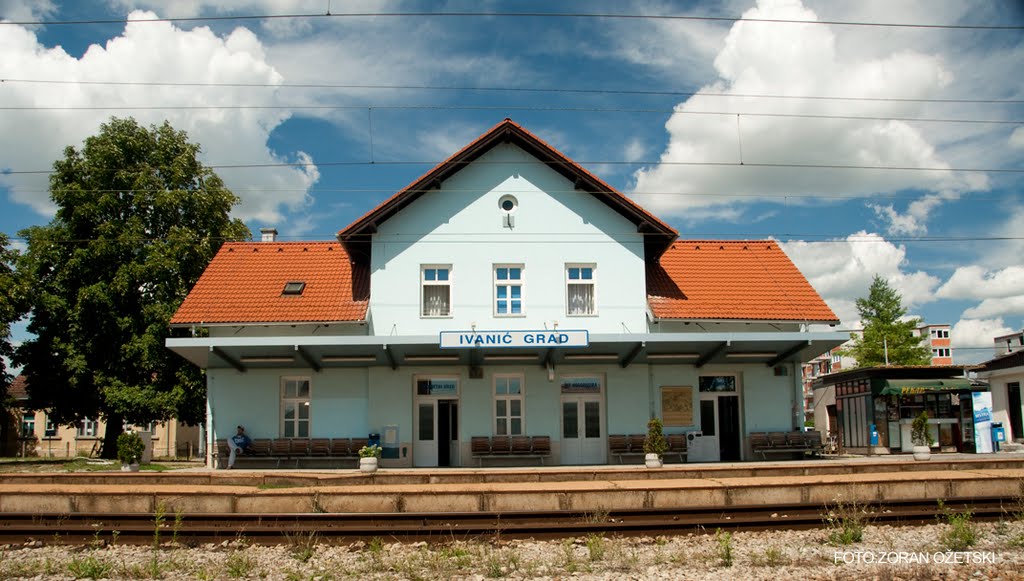 Ivanic-Grad train station © Zoran Ozetski / Grad Ivanic-Grad
Ivanic-Grad train station © Zoran Ozetski / Grad Ivanic-Grad
Smart City Ivanic-Grad is the name of the programme under which a series of energy-saving, eco-friendly and modern technologies is being adopted by the town. First came the introduction of free WiFi around the central city. The next stage of its grand connectivity investments come in the form of ultra-fast internet. By 2023, A1 Hrvatska will have invested more than HRK 77 million in the construction of the next-generation broadband access network that will enable internet speeds of up to 100 Mbit/s for residents of Smart City Ivanic-Grad, nearby Dugo Selo and the municipalities of Brckovljani, Kloštar Ivanić and Križ. The project is to be co-financed by the European Regional Development Fund. Construction will begin in the summer of 2021 and should be completed by the end of 2023. Ivanic-Grad © Visit Zagreb County
Ivanic-Grad © Visit Zagreb County
Another aspect to Smart City Ivanic-Grad's ambitions is Solar City Ivanić-Grad whereby a solar farm is set to be constructed throughout the city, with solar panels placed on public buildings. The energy produced by the panels will primarily be consumed by the buildings on which they are placed, with any excess energy delivered into the grid. So far, planned locations for the solar panels include five kindergartens, a museum, the college, library and university, a hall in Posavske Bregi, Alojz Vulinc Memorial Home, the Modular Wood Technology Entrepreneurship Incubator, Zelenjak Sports Park, the Old School in Dubrovčak Lijevo, the city administration building and two utility companies. The total value of the solar farm project is more than 10.2 million kuna, and the start of works is expected in the first quarter of next year.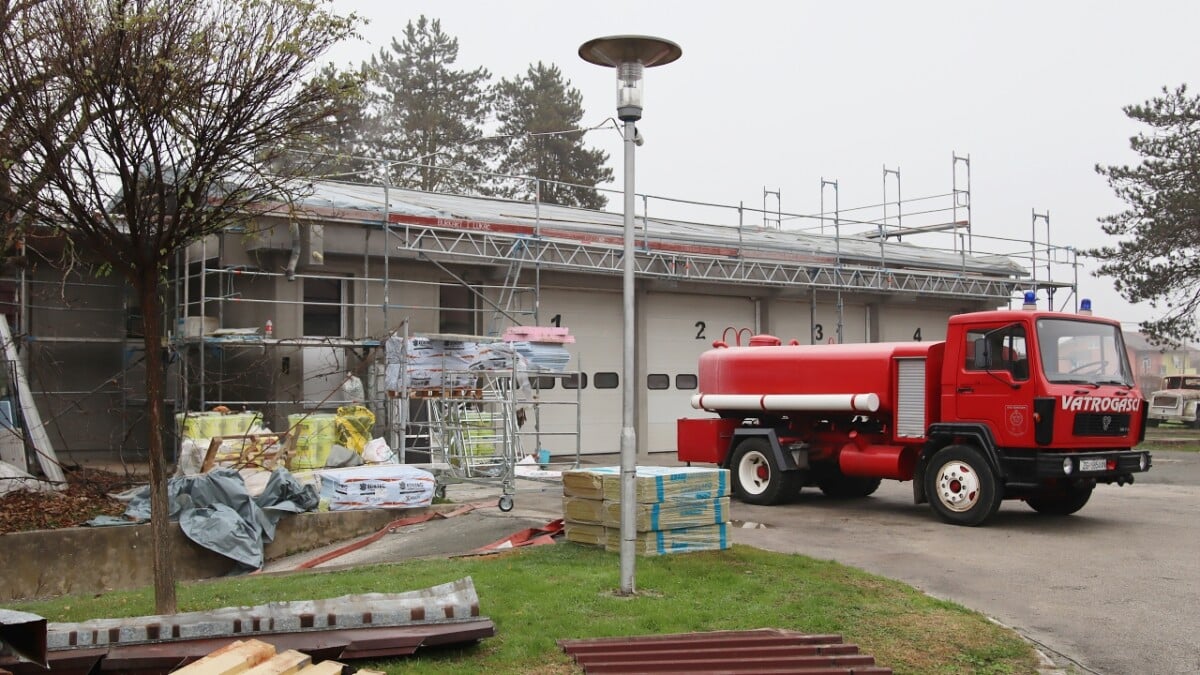 Energy-saving LED public lighting system has been introduced in Ivanic-Grad © Grad Ivanic-Grad
Energy-saving LED public lighting system has been introduced in Ivanic-Grad © Grad Ivanic-Grad
Already completed projects in the Smart City Ivanic-Grad scheme include LED public lighting, which saves 62% of energy consumption, a charging station for electric vehicles in Moslavačka Ulica, a smart bench near Ivan Švear High School and a system of public bicycles at three locations in the city.
Even nearer to Smart City Ivanic-Grad by train than the capital is Dugo Selo. As TCN reported last year, Dugo Selo will very soon be connected to a great wealth of European cities and countries by high-speed rail. It's less than 20 minutes to Dugo Selo by train from Ivanić-Grad. Soon, teenagers of the town will be able to cast their eyes down the tracks and have much more exotic destinations within reach than the regular day trips to Zagreb.
Newspaper: Gov't Will Have to Increase Teachers' Salaries by 6%?
ZAGREB, Dec 19, 2020 - The Supreme Court has dismissed a motion to review a Zagreb County Court ruling in favour of a Geology Institute employee who sued her employer over the non-payment of a base pay rise under an agreement dating back to the Ivo Sanader cabinet, Jutarnji List reported on Saturday.
This means the state risks being sued by many public sector employees which would cost the budget by over HRK 2 billion if the government does not reach an agreement with the unions which have already filed pilot lawsuits, all of which have been ruled in their favour, the daily said.
The pilot lawsuits have been filed over the non-payment of a 6% base pay rise in 2016 to which the Sanader cabinet committed in 2006. The global financial crisis followed, and the government and unions agreed in 2011 that the base pay would rise by 6% annually when GDP increased by 2% or more year on year over two consecutive quarters.
Said increase occurred in 2015, yet the government and the State Bureau of Statistics claimed that the GDP increase had not gone up by 2% but that, for the first time, they rounded it up to four decimals and that the increase was therefore 1.9998%.
That was when the first pilot lawsuits were filed. The Preporod union claims that 400 have been ruled in workers' favour and that 170,000 public sector employees could eventually benefit from this. Courts have awarded them amounts ranging from HRK 5,500 to 9,000.
On September 3, the education ministry ordered schools to initiate reviews if they lost the lawsuits. The ministry's position is that the prerequisites for applying the 2006 agreement were not met, given that it stipulates the deferral of the rise by as many quarters as GDP decreased, and that the rise therefore should have occurred only in January 2019, the newspaper said.
(€1 = HRK 7.5)


